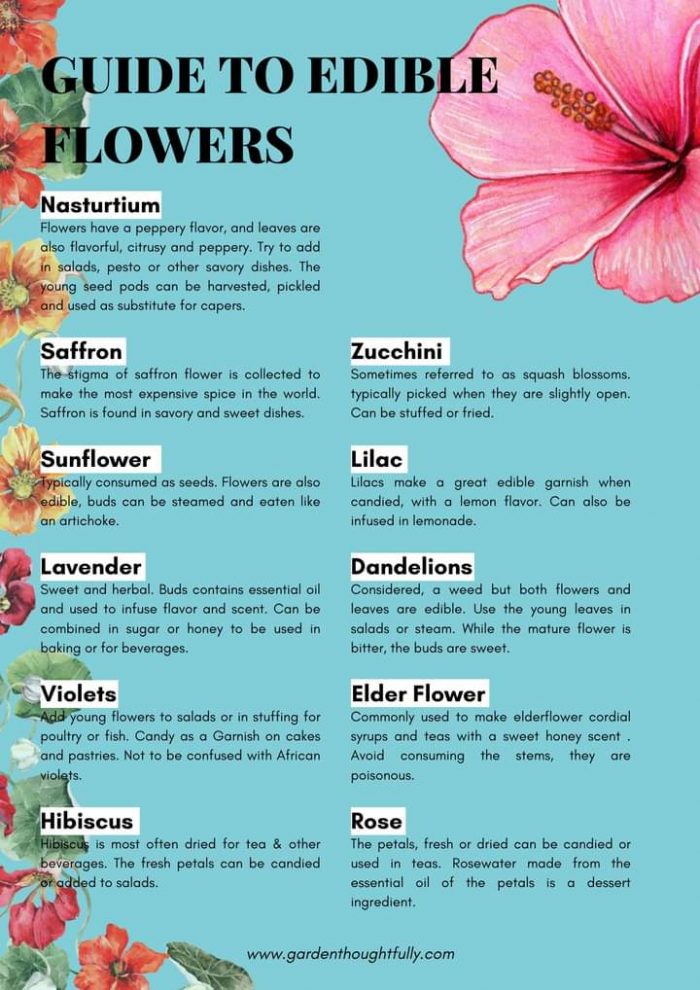
Edible flowers are a delicious way to add color and flavor to your dishes. They’re also incredibly nutritious, so you can enjoy them without any guilt! We’ve rounded up our favorite edible flowers below, including information about how to grow them and what they taste like. So get ready for a feast of bouquets: these blooms aren’t just for arranging anymore!
Nasturtiums
Nasturtiums are a great choice for edible flowers due to their high vitamin A content and antioxidant properties. They’re also a good source of vitamin C, which can help boost your immune system. The antioxidants found in nasturtiums make them great for skin health–they’re known to reduce acne and improve the appearance of scars from past breakouts. If you have sensitive eyes, nasturtiums may help combat macular degeneration by reducing free radicals within the body (which cause damage).
Saffron
Saffron is a spice derived from the dried stigmas of the saffron crocus (Crocus sativus). Saffron crocus grows to 20-30 cm (8-12 inches) and bears up to four flowers per stem. Each flower has three vivid crimson stigmas, which are collected by hand before sunrise and then dried for use in cooking, dyeing, perfumery and medicine. Saffron is native to Greece and Asia Minor where it has been cultivated since antiquity; it may have been first cultivated in Spain or Portugal but was later introduced into Italy by Arab traders who had brought it from Persia via India.
Zucchini flowers
Zucchini flowers are edible, and can be used in salads or as a garnish. To harvest zucchini flowers:
- Pick the male flowers (the ones with no pistils) before they open. The female flowers are larger than the males and have white pistils sticking out of them. It’s best to use both male and female varieties in your garden so that you get more fruit from your plants!
Once harvested, remove any stem attached to the base of each flower before preparing it for eating. You can either sautee them with butter or toss them into an omelet or frittata!
Sunflowers
Sunflowers are a great source of vitamin E, vitamin A and iron. They’re also easy to grow and can be eaten raw or cooked. The seeds are edible too–but they aren’t as nutritious as the flowers!
Lilacs
Lilacs are edible and a member of the olive family. They have a strong scent, but it is not unpleasant. Lilac flowers are edible and make a pretty addition to salads or desserts!
Lavender
Lavender flowers are edible and can be used in a variety of ways. You can use them to flavor your tea, or as a garnish on salads. If you’re feeling adventurous, try adding some lavender flowers to your next batch of homemade jam or jelly. Lavender oil is also an option for those who want to take their edible flower experience one step further–it’s an excellent way to scent your home!
Dandelions
Dandelion is a weed. It’s also a flower, vegetable, spice and tea–and sometimes all at once. The dandelion is one of the most versatile plants you can grow in your garden or yard. Not only does it make an excellent addition to salads and smoothies but it also has medicinal properties that help boost your immune system! The dandelion (Taraxacum officinale) is commonly found growing wild across North America and Europe as well as many other countries around the world including Russia, China and India where it has been used for centuries for its healing properties.
Violets
Violets are native to the eastern and central United States, where they grow in damp soil. They’re also popular in Europe, Asia and South America. Violets are edible flowers that can be used fresh or dried. Their leaves have a slightly bitter taste, but they’re also full of vitamin C and iron (one cup has more than half your daily recommended intake). The flowers themselves contain calcium and fiber–a serving has 2 grams of fiber! You can use violets on sandwiches or salads as garnish or even eat them straight off the stem like a fruit snack!
Elderflower (Sambucus nigra)
Elderflower is a flower that grows on elder trees. It has a sweet, delicate flavour and can be used to make tea, syrup and cordial. Elderflower is an ingredient in several cocktails, including the Elderflower Champagne Cocktail and the Hemingway Daiquiri. Elderflower is also known for its vitamin C content (one cup contains as much vitamin C as three oranges).
Hibiscus (Hibiscus acetosella)
Hibiscus flowers are a great edible flower to add to your salads or other foods. They can be eaten raw, but they’re better if you cook them first to release their flavor. Hibiscus is also used as a tea and jam ingredient, so if you have some extra hibiscus flowers lying around, make sure to try out some of these recipes!
If you’ve never tried edible flowers, now is the time. They are beautiful, tasty and nutritious. And if you’re not sure where to start with your flower garden, we’ve got some suggestions! But don’t worry–even if you don’t have access to any plants right now, there are plenty of ways to enjoy them at home (and even in your belly).
